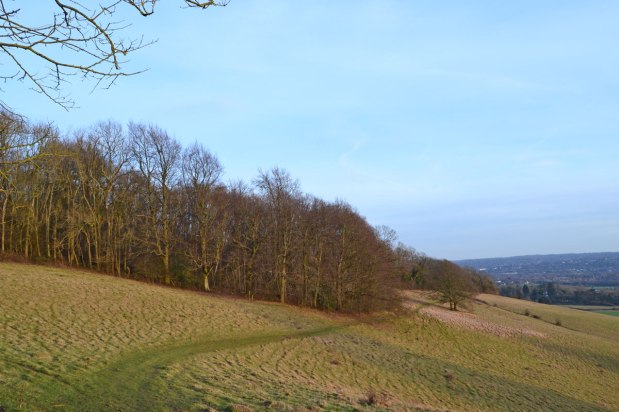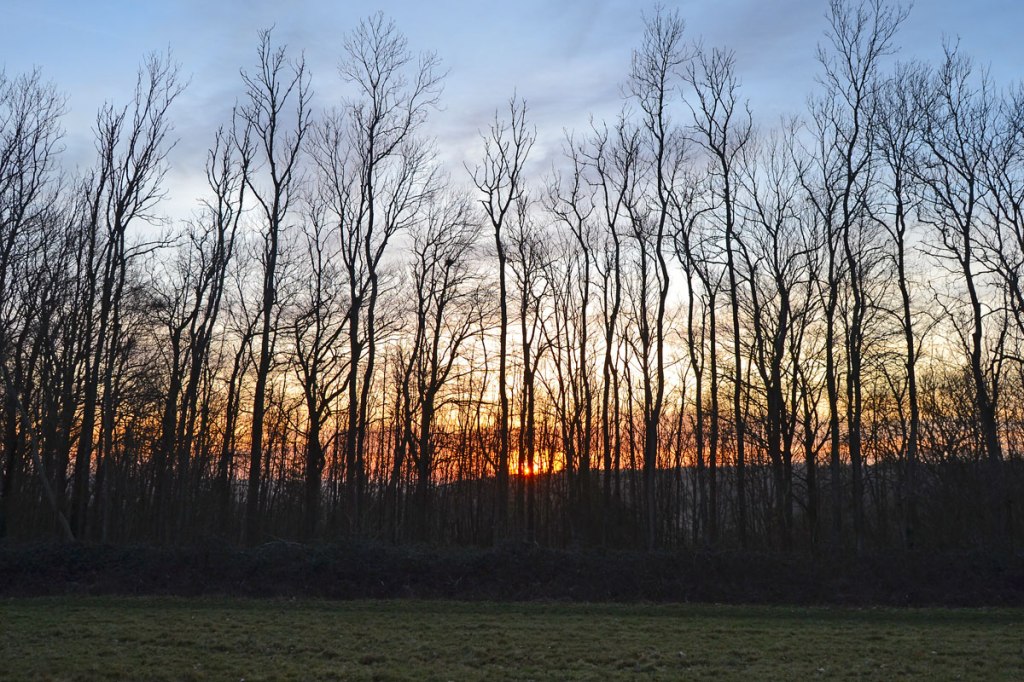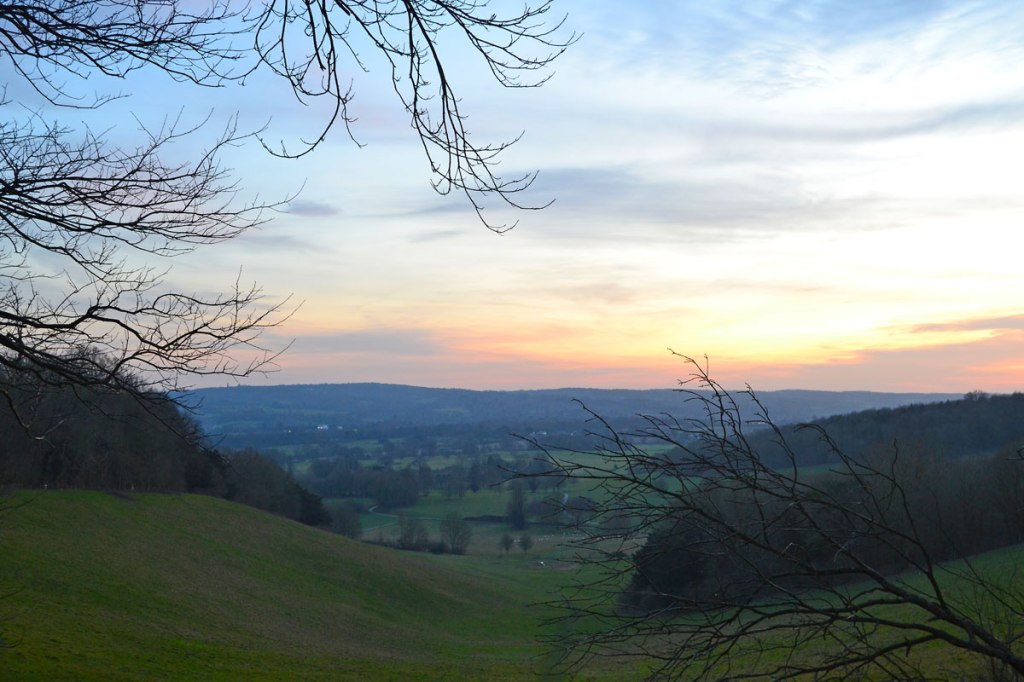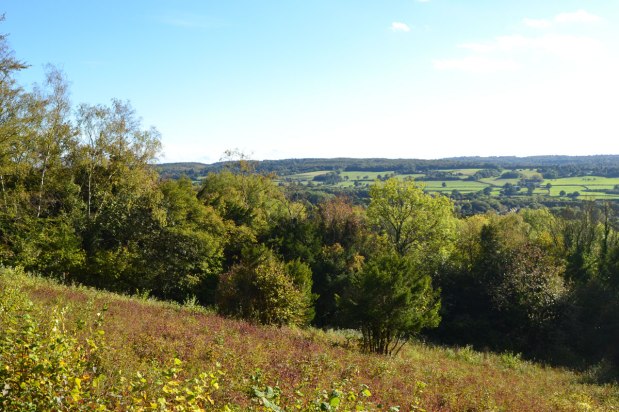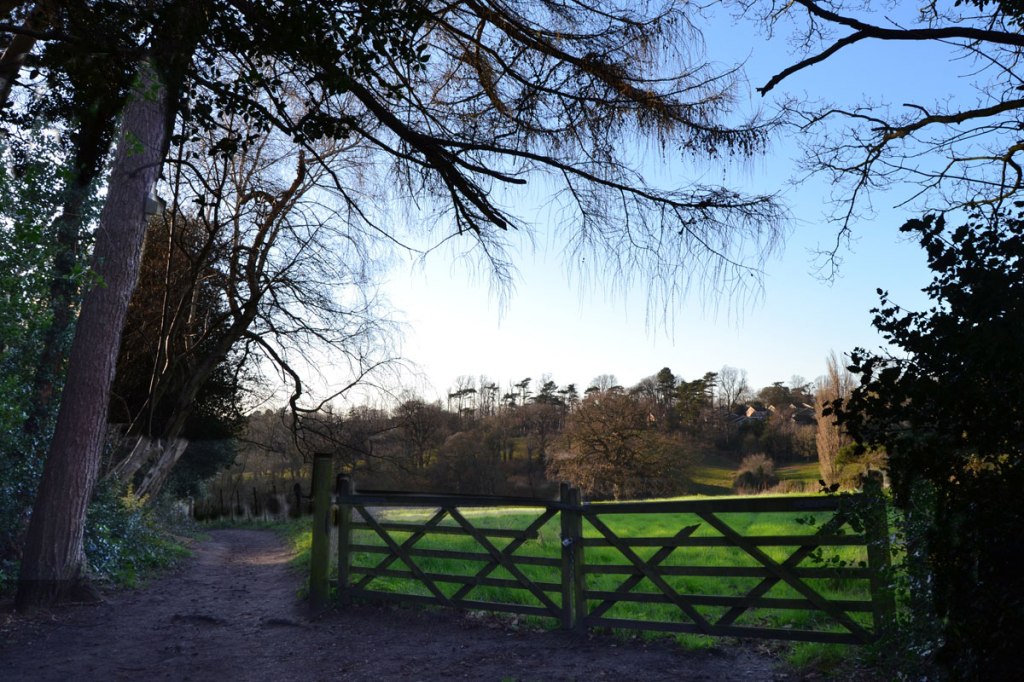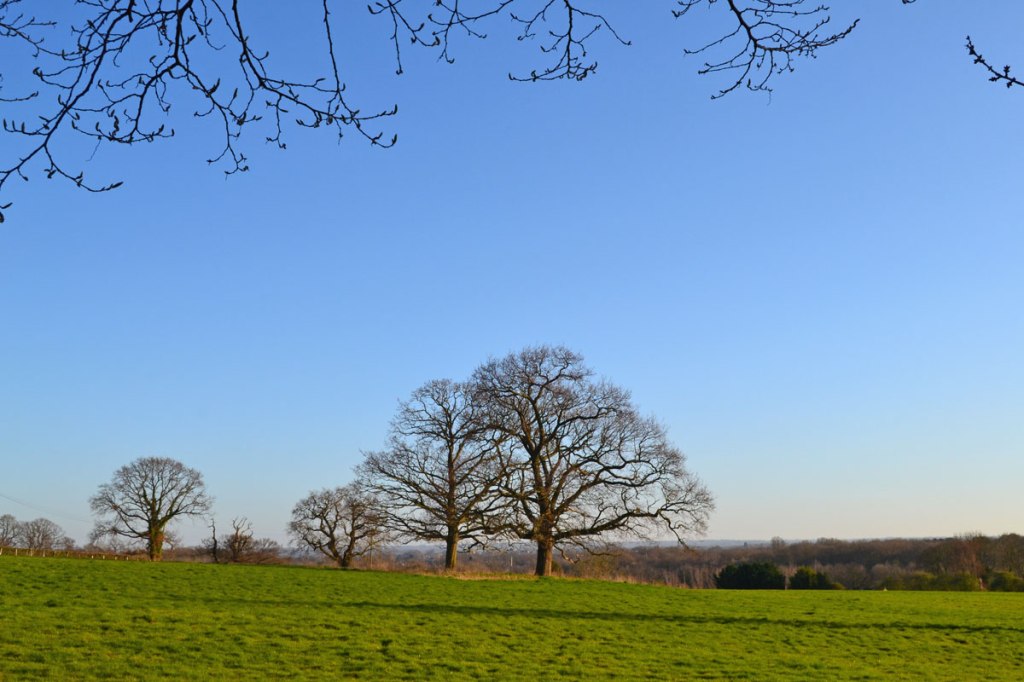A strangely mild January day; it looked as if it should have been cold and frosty. Instead, the late afternoon breeze wafting into the sunny North Downs escarpment at Knockholt Pound was tonally of southern Europe. I’d finished various tasks (which included watching tennis and football) by 2pm, which is about the cut off for setting off for a Kent Walk Near London in late January when darkness descends by 5.30pm. I found that even as dusk fell there were still carefree buzzards and kites drifting on the thermals across the dips and dry valleys, over sheep whose outlines caught the last of the sun making them appear luminous. As the sun set there was a gentle fall in temperature but by the time I reached the car there was still no real bite to the air and I reflected on the fact I could feasibly have done the whole walk in my T-shirt. It also occurred to me that I had encountered only one other person over the three miles of the route.
country walks
New route: Heaverham/Kemsing circular
This route, no 28, is similar to walk 27, but is better for people walking on Sundays, when there is no train service. You can start it from the lovely Chequers Inn, Heaverham (if you buy a drink/meal); Kemsing village car park; or Mon-Sat from Kemsing station. Rather like the Chevening/Knockholt walk it’s another chalk escarpment route that drops down into the Vale of Holmesdale, and uses short stretches of the North Downs Way. The link below includes the usual Google map and the more useful OS map, plus written directions. PDF to download will follow in a few days!
Click here for full description and maps






Early February sun, then gloom. But let there be jazz!
Last week, the Cudham walk was terrific with sunshine and wisps of high cirrus stippling the sky. The medieval flint church (pictured), shaded by ancient yews was beautifully lit as was the wonderful New Year’s Wood. There was little in the way of mud, but also few birds for some reason, even among the hedgerows. This drop off in the numbers of birds is something I’ve seen right across the walks lately. It seems to me that rich, well kept woodland areas such as Scords Wood and Petts Wood aren’t doing quite as badly as farming and pasture areas. This is what worries me about those new fences at Downe – does it mean more grazing and less space for wildflowers? Steve Gale’s blog North Downs and Beyond has some more on the drop off in bird populations. Steve is an expert observer of fauna and flora and has the experience to observe and record changes in numbers.
Unlike that sparkling Sunday in Cudham, the weekend just past was so gloomy that I only managed a brief cycle to Beckenham Place Park and back. I found little to inspire to be honest. Let’s hope for better in the weeks ahead.
Come along and enjoy top quality live jazz
Not venturing out at the weekend actually suited me as I needed to practise my saxophone (and watch some sport) in readiness for a gig tonight (Monday 13th). So if big band jazz is your thing come along to Sundridge Park WMC at 134 Burnt Ash Lane, BR1 5AF. It’s £6 to get in and the band starts at 8.30pm and finishes at 10.30 with a short break. There’s no need to book (you can’t anyway!) but there’s a decent bar at hand and lots of seating in a large room with good acoustics. The next performance after this is on 6 March at the same venue. The music we play is by arrangers and composers such as Thad Jones, Bob Florence, Gil Evans, Kenny Wheeler and Mike Gibbs, the sort of material performed by the Woody Herman, Stan Kenton, Count Basie bands etc. What else can you do on a bleak Monday night that’ll be as uplifting? Don’t answer that!
Bats in the mist – dusk at Downe, Keston and Polhill
Exceptionally mild temperatures have lured bats out into the autumnal gloaming to catch late flying insects. I love watching these animals swoop, flutter and flit around and it’s a bonus to see them so late in the year. Usually you can only pick them out against the sky but at Downe and Keston on last weekend’s strolls I was buzzed by bats so closely I sensed rather than saw them zooming past. Yesterday at Polhill one or two emerged from the mist to pass close over our heads before vanishing into the gloom.
I’d thought we’d set off rather too late for a walk. Traffic was bad on the A21 slowing us further (the train is by far the best option for Shoreham walks) and low cloud had covered the sky. But by Locksbottom the skies cleared and we were bathed in a beautiful golden light. This was a false dawn: by the time we parked up by Meenfield Woods above Shoreham we were in quite dense fog. This magically cleared at Polhill, the walk’s halfway point, to give us unusual views before swirling back in as the sun set. With the mist below we had the feeling we were much higher above the valley than we were. I think this weather effect is called a temperature inversion, where warmer air passes over the relatively cold air on the valley floor, causing condensation.
By the time we finished the walk, visibility was down to about 50 metres and driving home the twisty, twiny country lanes needed total concentration if we were to avoid a close encounter with a hedgerow.
A suburban saunter around Petts Wood
The Chislehurst station to Petts Wood station walk via the Hawkswood Estate might be ‘just’ a suburban saunter surrounded by 1930s mock Tudor, but it has loads going for it: it’s obviously great for public transport being between two stations with links to inner SE London; it’s near to London; it has surprisingly good views at points as far as Biggin Hill and Croydon; the woodland is beautifully managed by the National Trust with a huge variety of trees and restored patches of the heathland that was once common here; there are loads of paths to explore often crossing mysterious little streams running down to the lovely Kyd Brook river (which later becomes the Quaggy and joins the Ravensbourne); and it’s big, so makes for a decent workout. You can go off piste without really getting truly lost because the extensive woods are enclosed by suburbia. On the other hand you can adapt it into a much longer walk taking in Scadbury Park nature reserve and Jubilee country park, both adjacent to the Petts Wood/Hawkwood hub. There are usually plenty of people around, in my experience mostly very friendly and with docile pooches. Owls can be seen and heard at dusk and woodland birds proliferate here.
Today, in glorious late March weather, it was a picture. My route is intended as a guide to some of the best bits: the heather areas with their raised path embankments; the central fields with their long views; hidden ponds and mires; chestnut groves; the Willett Memorial glade; pine clumps and bluebell vistas. And once you leave the woods to get to the station, there are quite a few interesting inter-war houses and gardens, and the town of Petts Wood doesn’t disappoint when it comes to food and beverages.
Tiny lanes, dry feet
The mud on these walks is still in the mild-moderate category. Wellies useful but not essential… mostly. But if things get really boggy, which they are bound to do by midwinter, it’s easily possible to devise routes that take in tiny wandering lanes rather than swampy paths – of which there are more than few in these parts. Many such lanes were once paths… others service dispersed houses around villages and become footpaths or bridlepaths. It would be difficult to devise a proper circular walk of decent length using only these trackways – although I intend to give it a shot over the coming months. Two such lanes which intersect with a walk at KWNL are at Underriver. Take a look at the map; you’ll see two lanes roughly north to south acting as shortcut links between points 4, 5 and 8. These are lovely to explore, especially at the moment with the unfurling of the autumn wardrobe. They also intersect with footpaths so you can devise your own bespoke routes. With bird expert Dave I walked them yesterday, stopping often to admire berries and views, and to scan for les oiseaux. We didn’t see a lot (bird numbers have been in decline for years): a few siskins, a gorgeous flock of bullfinches flitting the hedgerows, and newly arrived redwings in threes and fours was about it. Oh, and a fantastic female kestrel which eyed us from a small scarlet tree close to the (excellent) White Rock Inn. We managed about 3.5 miles, half on tarmac, before resuming the Underriver route at point 4, but doing it anticlockwise. A pint of Harvey’s at the aforementioned pub in the autumnal twilight was a splendid bookend to a most satisfactory KWNL afternoon.
Microclimates and wild meadows
The Darent Valley and its surrounding valleys near Otford, Romney Street and Austin Lodge to the east and Andrew’s Wood to the west seem to me to trap heat and moisture. Even on dull summer days the area feels more humid and sticky than the London suburbs for example. I love it. The area feels ‘different’ and somewhat mystical. It’s certainly very verdant and with rewilding projects, such as at Magpie Bottom, several SSSIs and Kent Wildlife Trust reserves, it’s worth having to change your shirt for. Just take a flask of water. Even on a mostly dull day like last Sunday, you might get a fleeting pool of sunshine to enjoy and the sight of cloud shadows racing across the rippling wildflower rich meadows towards you. (Dogowners are advised to keep their animals on the the lead though…. there’s apparently a threat of adder strikes on dogs in the area and occasionally livestock. Cases of dog theft have occurred too.)
Sweet meadows
The word ‘meadow’ is synonymous with summer and June and July are the very best months to enjoy them. There are so many brilliant summer meadows on these walks now alive with oxeye daisies, orchids, vetch, poppies, buttercups, and lush grasses rippling in the breeze. They are alive with butterflies and other insects while swallows swoop above them forming brief gaggles before separating to make single passes. High above, buzzards are often seen soaring while spectacular red kites – now much common in Kent than at any time in the modern era – float into view closer to the ground. Of course there are issues, swallow and martin numbers are much lower than back in the day and there ought to be more butterflies and bees. Still, meadows are hubs for wildlife and we are lucky the North Downs, Weald and Greensand Ridge areas possess so many.

Joining up the Shoreham walks for an epic
Windy, cold, grey, damp. Yep, this May is a shocker. We needed the rain yada yada (or yabba yabba, take your pick). I won’t go on leisure cycles in this kind of weather, but walking is still a possibility if the wind drops. I know, it’s hard to believe I’m talking like this – it’s May in south east England! My walking activities do mean I have some accurate memories of weather and there were a couple of days not dissimilar to this last May. But only a couple. Anyway, for once I had time last weekend to devise an epic by joining up group of routes. Some old friends were joining me from west London; so we wanted to stretch our legs and truly earn that pint at the end. So we took on the Shoreham eastern valleys walk joined it up with a section of the Fackenden Down route then slipped into Shoreham circular mk2 before segueing smoothly into half of Shoreham mk1, taking in the Meenfield wood bluebells.

On the map it looked to be 8.5 to 9 miles but we reckoned it was about 11.5 miles with our inability to walk straight and a diversion to see the Percy Pilcher memorial. Back in the village the choice was between the Crown, the King’s Head or the Mount Vineyard for the aprés. We settled on the vineyard for its proximity to the station, though both the pubs were passed with regret. In the manner of a walk in the Highlands or west Wales we encountered a number of different weather conditions – beginning with a colourful combination of shades of grey at different levels punctuated by shards of blue sky and varying degrees of sun.

What with the multitude of greens and yellow tones in the woods and fields the effect was dazzling at times. But as we left Magpie Bottom a period of nimbo stratus with heavy rain fell upon us and we emerged at the top of Fackenden Down with that great view shrouded in mist and ragged low cloud. But by the time we’d left the hillside after sheltering we were in bright sunshine and what felt like a 10C rise in temperature. Finally, at the vineyard, we caught the edge of a thunderstorm somewhere around London bringing further rain. In the sunny bits buzzards soared, yellowhammers posed on the tops of hedgerows – with blackcaps, robins and whitethroats chirping away within – and Spitfires from Biggin Hill growled overhead. All part of the Kent wonderland.
I’ve surrendered to the mud
The mud I’ve encountered out walking is worse this year than in any other I can remember (much worse than the picture I’ve used from Meenfield wood suggests). It has been much wetter than normal, with regular heavy rain over the past two months, but the number of people out and about is another major factor in churning it up. It’s going to take some paths a long time to recover I suspect.
The situation in parks is the same, though of course there are more hard surfaced paths to take; I cycled over to Beckenham Place Park earlier and there are patches of mud where there should be grass in many places. The number of people in the park was good to see; surely it’s better to see everyone in the fresh air trying to enjoy themselves and keep body and soul together than not. On the other hand social distancing was a problem and there were some large groups. Hardly anyone wore a mask, strangely. I know transmission of Covid is thought to be unlikely in the open air but, still, with so many people surely a mask might add a little extra security. We do it on railway platforms so why not in parks? The air was very still, too – something to consider? I’m not sure. Truly remarkable were two ice cream vans down by the car park. That’s not in the spirit of lockdown at all. And it felt about 1C. I still can’t believe it. A deadly plague, it’s 1C and we’re queueing for ice cream or coffee?

One Tree Hill… snow and a river of liquid mud instead of a path
Anyway, back to mud. If using Kent Walks near London for the first time I feel I should point out that the walks are, for 9 months of the year, much better than this squelchy experience! Even with wellies you have be careful not to slip over in it and stretches of up to 100 metres are fraught on some routes. Steep hills are out of the question. Maybe – and it goes against the grain with me to write this – it’s time to leave the countryside alone for a bit. Either join the hordes in the local park (but with a mask and careful distancing) or trudge the streets. Sorry.

